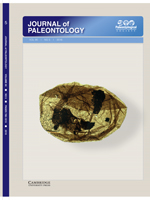A macrofloral assemblage dominated by elements of the Euramerican dryland biome is described from the Brazil Formation in Clay County, Indiana (Illinois Basin). Fossils were recovered from a thin heterolithic unit between a shallow-marine bed and the paleosol beneath the Minshall Coal, a Middle Pennsylvanian succession deposited near the Atokan-Desmoinesian and Bolsovian-Asturian boundaries. Sedimentological indicators imply accumulation under a seasonal climate, including interbedded siltstone and sandstone deposited during flashfloods, intraclasts eroded from local sources, and charcoal produced by wildfires. The macrofloral assemblage is consistent with a dryland setting, being dominated by large, coriaceous gymnosperm leaves with mesic to xeric traits, including Cordaites spp. indet., Lesleya sp. indet., and Taeniopteris sp. cf. T. multinervia. Sphenopsids and ferns typical of the wetland biome are rare. In contrast, the microfloral assemblage is dominated by fern spores, with lesser lycopsid spores and cordaitalean pollen. The succession indicates that the dryland biome predominated during late regression, prior to the onset of perhumid conditions that resulted in peat accumulation at late lowstand. However, the abundance of palynomorphs from wetland vegetation implies gradual fragmentation of the prevailing dryland flora and replacement by the wetland biome in the transition to glacial maximum. The taphonomic and paleobiogeographic context confirms that floras adapted to seasonal moisture deficit periodically dispersed into tropical lowlands, rather than being transported from ‘extrabasinal’ or ‘upland’ environments. The precocious occurrence of Taeniopteris, more typical of Late Pennsylvanian and Permian floras, may be the earliest record of the fossil-genus, and exemplifies the association of derived plant taxa with dryland habitats. The predominance of broad-leaved gymnosperms with mesic to xeric characters suggests that dryland communities contained more slow-growing and long-lived plants than contemporaneous wetland floras.
How to translate text using browser tools
1 September 2016
Dryland vegetation from the Middle Pennsylvanian of Indiana (Illinois Basin): the dryland biome in glacioeustatic, paleobiogeographic, and paleoecologic context
Arden R. Bashforth,
William A. DiMichele,
Cortland F. Eble,
W. John Nelson
ACCESS THE FULL ARTICLE

Journal of Paleontology
Vol. 90 • No. 5
September 2016
Vol. 90 • No. 5
September 2016




